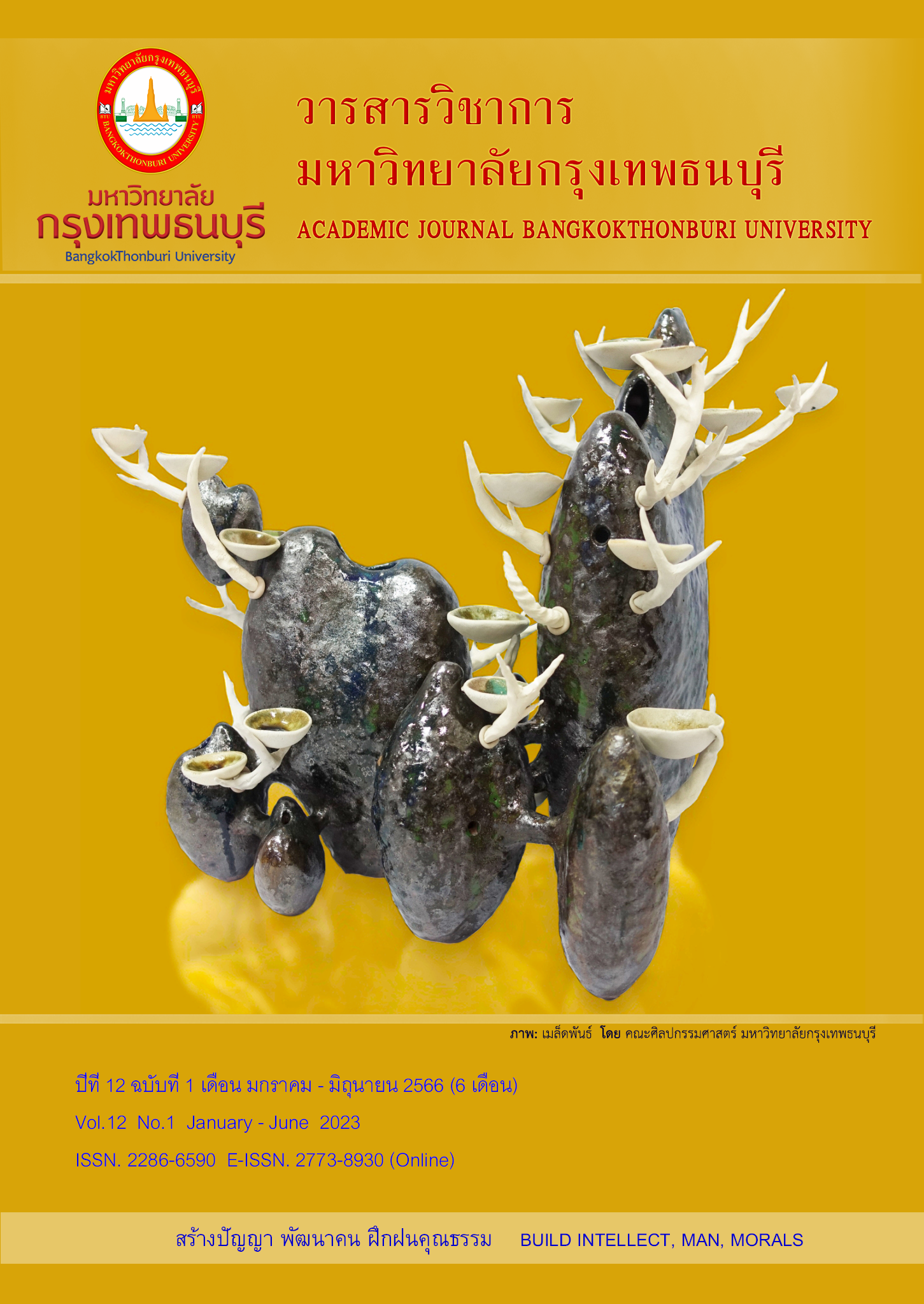The Effect of Movement and Rhythm Activities Based on Carl Orff Approach Affecting Preschool Children’s Creativity at Banbangnamjued School, Samut Sakhon Province
Main Article Content
Abstract
The purpose of this research was to compare preschool children’s creativity before and after implementation of movement and rhythm activities based on Carl Orff approach. The population used in this research were 40 preschool children from 2 classrooms, aged between 4 - 5 years old, attended Kindergarten year 2 in the first semester of academic year 2022 at Banbangnamjued school in Samut Sakhon province. The samples of 20 preschool children from Kindergarten year 2 room 2 were selected by using cluster random sampling. This was a quasi - experimental research with one - group pretest - posttest design. The experiment took 8 weeks. The instruments used in this research were movement and rhythm activities based on Carl Orff approach lesson plans and the preschool children’s creativity test with the reliability at .86. The statistics used to analyze the data were mean and standard deviation. The Index of Item Objective Congruence (IOC), difficulty index (P), discrimination Index (B), validity by using Kruder - Richardson (KR - 20) were used to find the quality of the instruments, and statistic testing hypothesis was dependent samples t - test.
The result found that preschool children’s creativity after implementation of movement and rhythm activities based on Carl Orff approach was higher than before the experiment with statistically significance at .05 level.
Article Details

This work is licensed under a Creative Commons Attribution-NonCommercial-NoDerivatives 4.0 International License.
References
ตฤณ แจ่มถิ่น. (2561). เด็กปฐมวัยกับการพัฒนาความคิดสร้างสรรค์ (Creativity in Early Childhood Development). สาขาวิชาการศึกษาปฐมวัย คณะศึกษาศาสตร์. มหาวิทยาลัยจันทรเกษม.
เทพรัตน์ พานิชยิ่ง. (2553). ผลของการใช้กิจกรรมดนตรีตามแนวคดของออร์ฟ ที่มีต้อความคิด สร้างสรรค์ของนักเรียนระดับปฐมวัย โรงเรียนสาธิตมหาวิทยาลัยศรีนครินทรวิโรฒประสานมิตร (ฝ่ายประถม) เขตวัฒนา กรุงเทพมหานคร. ปริญญานิพนธ์การศึกษามหาบัณฑิต, สาขาจิตวิทยาการศึกษา มหาวิทยาลัยศรีนคริทรวิโรฒ.
ธวัชชัย ศรีเทพ, ชลาธิป สมาหิโต, และปัทมา เล่ห์มงคล. (2558). การจัดประสบการณ์ดนตรีตามแนวคิคคาร์ล ออร์ฟ เพื่อพัฒนาทักษะทางสังคม – อารมณ์ของเด็กออทิสติกในระดับปฐมวัย. วารสารศึกษาศาสตร์ปริทัศน์. 32(2), 110-112.
เกตุมณี เหมรา และชลาธิป สมาหิโต. (2559). การจัดกิจกรรมสะเต็มศึกษาเรื่องของดีเมืองร้อยเอ็ดเพื่อพัฒนาความสามารถในการแก้ปัญหาของเด็กปฐมวัย. วารสารศึกษาศาสตร์ปริทัศน์. 31(3), 153-160.
ประจักษ์ ปฏิทัศน์. (2562). การคิดเชิงระบบและความคิดสร้างสรรค์. สำนักพิมพ์จุฬาลงกรณ์มหาวิทยาลัย: กรุงเทพมหานคร.
ยุภาดี ปณะราช. (2565). สถิติเพื่อการวิจัยทางการศึกษา (Statistics For Research Education). (ตีพิมพ์ครั้งที่ 2). กรุงเทพฯ: สำนักพิมพ์จุฬาลงกรณ์มหาวิทยาลัย.
โรงเรียนบ้านบางน้ำจืด. (2564). รายงานการประชุมกรรมการบริหารสถานศึกษาโรงเรียนบ้านบางน้ำจืด ครั้งที่ 6 ประจำปีการศึกษา 2564. สมุทรสาคร: โรงเรียนบ้านบางน้ำจืด.
ศุภรักษ์ ฮามคำไพ, ณรงค์ฤทธิ์ อินทนาม และธิดารัตน์ จันทะหิน. (2563). การพัฒนาความคิดสร้างสรรค์ของนักเรียนชั้นอนุบาลปีที่ 2 กลุ่มเครือข่ายสถานศึกษาที่ 14. วารสารวิจัยและประเมินผลอุบลราชธานี, 9(2), 140-148.
สุปรีดา นาพี. (2563). การจัดประสบการณ์การเรียนรู้ โดยใช้ชุดกิจกรรมศิลปะสร้างสรรค์เพื่อส่งเสริมความคิดสร้าง สำหรับนักเรียนชั้นอนุบาลปีที่ 2. วารสารเทคโนโลยีและสื่อสารการศึกษาคณะศึกษาศาสตร์ มหาวิทยาลัยมหาสารคาม, 3(8), 96-106.
อารี พันธ์มณี. (2547). ฝึกคิดให้เป็น คิดให้สร้างสรรค์. กรุงเทพฯ: สำนักพิมพ์ใยไหม.
อัญชลี ไสยวรรณ และวรดี เลิศไกร. (2564). เอกสารประกอบการสอน วิชาการจัดประสบการณ์ การเรียนรู้สำหรับเด็กปฐมวัย. คณะจิตวิทยา มหาวิทยาลัยเกษมบัณฑิต.
Guilford. (1959). Personnality. New York: Mcgran Hill Book Company.
Guilford. (1967). The Nature of Human Intelligence. New York: McGraw-Hill Book Co.
Torrance, E. P. (1969). Rewarding creative behavior: Experiment in classroom creativity. Englewood Cliffs, NJ: Prentice-Hall.


